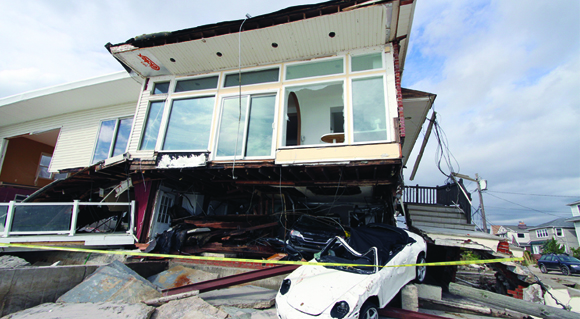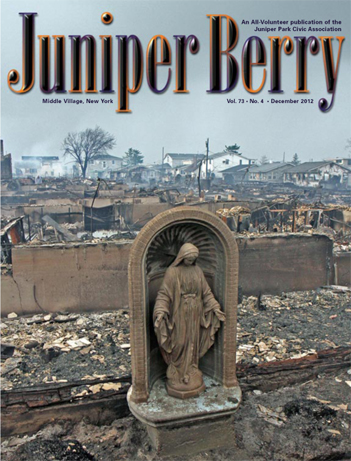Hurricane Sandy hit the New York area on Sunday, October 28, 2012. The devastation to New York and New Jersey was reminiscent to the destruction of Hurricane Katrina when it flooded New Orleans in 2005. Weeks later many are still amazed at the sheer level of damage to the Metropolitan area.
If you’re from Queens, the destruction to the Rockaways will have a profound impact. A generation from now, people will tell their kids what it was like to live through the storm and its aftermath.
Driving from Middle Village into Rockaway is a gradual reduction of modernity culminating in the destruction of an iconic New York neighborhood. As you begin to drive into Ozone Park you notice street lights begin to go out. By the time you’re into Howard Beach none of them are working. Further down Cross Bay Boulevard into Broad Channel you’ll notice a boat blocking the road heading north causing traffic for anyone trying to leave the peninsula. Next to the boat someone posted a large sign, which reads: “Broad Channel, the Forgotten Town!” As you cross over the bridge into Rockaway you have fully transitioned into another world.
Growing up in Queens it is impossible not to have some fond memories of Rockaway beaches. New York City has many sites for tourists, but the Rockaway beaches are for people who live in New York. Coming over the bridge your memories are instantly shattered by the harsh reality now confronting Rockaway residents. Sand filled streets, burned out buildings, overturned cars and never-ending piles of dirt and trash is the new scenery.
We dropped off supplies and volunteered at St. Francis De Sales, a staging area for distribution throughout the hardest hit areas of the City. I parked in a random person’s driveway about a block away. Just walking that block your senses are bombarded with an incredible amount of activity going on around you. From people cooking food, looking for supplies and just milling about, it’s as if everyone in Rockaway was either cleaning their home or just hanging out in the street not wanting or being able to go inside. Just like a first person viewpoint in an action movie, it’s hard to process all the activity going on around you.
We dropped off our supplies at the church and then joined dozens of others hauling supplies off trucks and bringing them into the church. Everything from diapers to Advil is needed. At least as of Saturday November 10th, people were still vehemently angry over the lack of support from the Red Cross and FEMA. Most of the support infrastructure established was coming from local churches and random volunteers such as us. At this particular church certain people tried to take charge and come up with a process for organizing and distributing supplies but you could see them struggling. The dedication of Rockaway residents and all those coming into the area to help is heartwarming. It is easy to be cynical about society. But people are still coming together more so than tearing each other apart.
Of course, society isn’t perfect. For the most part you feel safe but it is a bit dangerous and I would recommend no one go there after dark. Several people tried to literally take the supplies right from your hand even before they get dropped off for sorting and distribution. One volunteer pulled up on his bike, got off and within 30 seconds someone was trying to steal his bike. Around 3:30 pm, a volunteer got on the megaphone and was trying to get people to stay into the night. After every call for help, though, he would interject and say, “Look, it’s going to get dangerous.” He probably said the word “dangerous” 3 or 4 times in his 30-second speech which was supposed to incite people to stay into the night.
While looting is always a concern after natural disasters, one of the less talked about dangers is the air in Rockaway. There is a permanent sand/dust cloud over the whole neighborhood – some areas worse than others. While breathing in tiny sand and dirt particles are tolerable for a day at the beach, doing so day after day can be a health risk. But this isn’t even the worst of it. Due to flooding a substantial portion of the population has to clean out their homes. In many cases this will mean completely ripping out the insides of houses to avoid the dangers of mold growing on the walls. Naturally, people are throwing the debris from their homes into the streets, spewing the area with a variety of microscopic chemicals harmful to people’s health. If one or two homes on someone’s block was doing this type of construction the health effects are probably minimal, but right now EVERYBODY who owns a home is taking this action. As time goes on it is entirely possible that people will suffer respiratory ailments from breathing in the Rockaway air.
During the storm and into the recovery there are never ending accounts of bravery and charity. During the storm, members of the Point Breeze Fire Company had to dive underwater to connect their hoses in order to fight the fire, which eventually consumed over 100 homes.[1]
Following the storm, the Kiwanis Club of Glendale went to Hamilton Beach Fire House two weekends in a row to serve hot meals to those displaced. One couple the Kiwanis Club met while volunteering drove down from upstate New York after cooking at least eight trays of food. According to the volunteer fire department, the same couple was there the previous weekend and brought eight generators to Hamilton beach for whoever needed them.[2]
In the months and years to follow Rockaway and the other effected areas will need our continued support. Long after this story is no longer the headline in the national media, the effects of the storm will still be with the people of New York City. We should brace ourselves for the long haul.
[1] This story was told to the author by Vincent Arcuri, Chairman of Community Board 5
[2] This story was told to the author by Millie Mandese, Board Member of the Kiwanis Club of Glendale




